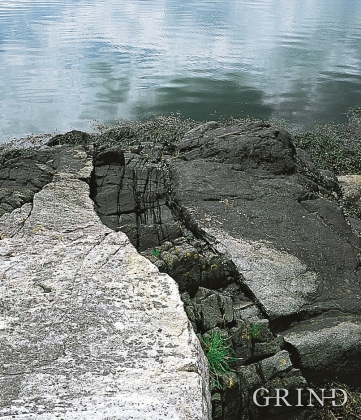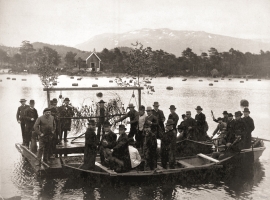Published: 25.07.2015 | Author: Haakon Fossen
At the head of the bay in Espevik the diabase sills are clearly visible as black, sunken stripes or bands in the mountainside. These darker rocks are vestiges of the glowing hot mantle under the earth's crust. The dark sills are easily distinguished from the lighter host rock. There is a roughly 270 million year age difference between the two. (Svein Nord)
VISIT FROM THE UNDERWORLD
220 million years ago, glowing hot molten rock masses intruded into fractures in the earth's crust in the outer parts of Hordaland. Some of these are believed to have reached the surface and formed lava flows, which since have been eroded away by wind and weather. But, most of these flows solidified into diabase sills before they got to the surface.
The best preserved of these is found in Espevik on Tysnes. When these dramatic events unfolded, what is now the earth's surface lay several kilometres underground. Today, we see the remains of the magma that filled the cracks in the earth's crust. The magma followed the many steep faults along the coast, faults that created valleys, straits and fjords trending in a north-northwesterly direction. This fracture system must have stretched quite far down, to great depths. The magma came from over 50 kilometres depth (the mantle) and has intruded right through the crust on its way to the surface. The magma that was left in the fractures can be found as diabase sills, that is, fine-grained alkaline magmatic intrusions.
One finds nearly a hundred such sills, from Sund in the north to Sveio in the south. At the head of the bay in Espevik one can see many of these dark sills. Here, they have also been dated. By studying the isotopes in the element argon, it has been discovered that they are about 220 million years old (from the Triassic Period). In other places (i.e. on Sotra), the dating reveals intrusions also in Permian times, about 250 million years ago. This is quite far back in time, but the sills are nonetheless the youngest rocktypes on dry land in Hordaland. Only in the undersea Bjorøy tunnel is the bedrock younger.
Sills
The sills are magma that has solidified on its way up through the fractures in the earth's crust from a deeper source of molten rock. A sill is usually about one metre wide or smaller, but can penetrate inwards into the mountainside and downward underground. If the magma reaches the surface, it is called lava.
Members of the "Oyster Company of Norway" on inspection to the Espevikpollen oyster dam in 1886. Among them are many distinguished people, including the later Prime Minister Gunnar Knudsen. Espevikpollen oyster dam has a long tradition of oyster-growing, and is one of the few places in Hordaland where oyster farming has continued right up until our time.
- Fossen, H.; Dunlap, W. J., 1999. On the age and tectonic significance of Permo-Triassic dikes in the Bergen-Sunnhordland region, southwestern Norway. Norsk Geologisk Tidsskrift 79:169–178.
- Færseth, R. B. 1978. Mantle-derived lherzolite xenoliths and megacrysts from Permo-Triassic dykes, Sunnhordland, western Norway. Lithos 11:23–35.
- Færseth, R. B.; Macintyre, R. M.; Naterstad, J., 1976. Mesozoic alkaline dykes in the Sunnhordland region, western Norway: ages, geochemistry and regional significance. Lithos 9:331–345.
- Valle, P.; Færseth, R. B.; Fossen, H., 2002. Devonian-Triassic brittle deformation based on dyke geometry and fault kinematics in the Sunnhordland region, SW Norway. Norsk Geologisk Tidsskrift 82:3–17.





